billy the kid

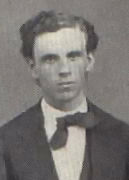 There are wars between nations, and then there are wars between gangs. The Lincoln County War of 1878 was the latter. The war started when John Tunstall was murdered. John Tunstall’s murder was really the culmination of the ongoing conflict between two factions who were competing for profits from dry goods and cattle interests in the county. James Dolan dominated the older and more established faction, operating a dry goods monopoly through general store referred to locally as The House. The other faction was run by English-born John Tunstall and his business partner Alexander McSween, who opened a competing store in 1876, with backing from established cattleman John Chisum. The Tunstall-McSween faction gathered lawmen, businessmen, Tunstall’s ranch hands, and criminal gangs to their assistance. The Dolan faction was allied with Lincoln County Sheriff Brady and aided by the Jesse Evans Gang. The Tunstall-McSween faction organized a posse of armed men, known as the Lincoln County Regulators, and had their own lawmen consisting of town constable Richard M Brewer and Deputy US Marshal Robert A Widenmann.
There are wars between nations, and then there are wars between gangs. The Lincoln County War of 1878 was the latter. The war started when John Tunstall was murdered. John Tunstall’s murder was really the culmination of the ongoing conflict between two factions who were competing for profits from dry goods and cattle interests in the county. James Dolan dominated the older and more established faction, operating a dry goods monopoly through general store referred to locally as The House. The other faction was run by English-born John Tunstall and his business partner Alexander McSween, who opened a competing store in 1876, with backing from established cattleman John Chisum. The Tunstall-McSween faction gathered lawmen, businessmen, Tunstall’s ranch hands, and criminal gangs to their assistance. The Dolan faction was allied with Lincoln County Sheriff Brady and aided by the Jesse Evans Gang. The Tunstall-McSween faction organized a posse of armed men, known as the Lincoln County Regulators, and had their own lawmen consisting of town constable Richard M Brewer and Deputy US Marshal Robert A Widenmann.
The highly volatile situation came to a head on April 4, 1878, in what became known as The Gunfight at Blazer’s Mill. The shootout was between the Lincoln County Regulators and buffalo hunter Buckshot Roberts. The Regulators, led by Richard “Dick” Brewer, included Billy the Kid and Charlie Bowdre. They began the process of hunting down anyone believed to have been associated with the murder of John Tunstall, which had initially sparked the Lincoln County War. Still, the conflict had been long in the making. Roberts had already been implicated in crimes associated with the “Murphy-Dolan” faction. Nevertheless, the reality is that he probably had nothing to do with the ongoing range war.
Blazer’s Mill located on a hillside between Lincoln, New Mexico and Tularosa, was owned by a dentist named Dr Joseph H Blazer. It was more than just a mill. The property included a large two-story house, a large square office building, a sawmill, a grist mill, several one-story adobe structures and houses, a post office, a general store, and a number of corrals and barns. I suppose it was rather a local hang out. The Regulators had killed Sheriff Brady and Deputy Hindman three days earlier, and they were in Blazer’s Mill to have a good meal at Mrs Godfrey’s Restaurant. The Regulators, who were there that day included Brewer, Bowdre, William McCarty (aka Billy the Kid), Doc Scurlock, Frank McNab, George Coe, Frank Coe, John Middleton, Jim French, Henry Newton Brown, Fred Waite, and several others who were not as well-known.
Not everyone was ready for this war. In fact, Buckshot Roberts wanted no part of the Lincoln County War. He had even made plans to leave the area. He sold his ranch and was just waiting for the check from his buyer. On April 4th, 1878, Roberts rode his mule into Blazer’s Mills. He was there to collect his check, but he was shocked to discover that the Regulators entire upper echelon was there, eating lunch in a nearby building. After killing Sheriff Brady just three days earlier the men had left the area around Lincoln, New Mexico after killing Sheriff Brady just three days earlier, but had brazenly stopped to have dinner at Mrs Godfrey’s Restaurant, before leaving the area. One of the Regulators…Frank Coe, was sitting with “Buckshot” Roberts on the steps of the main house. Coe was trying to talk Roberts into turning himself in. Roberts refused. He figured that if he turned himself in, he would be killed by the cowboys, out for revenge.
Meanwhile, Regulator chief, Dick Brewer was growing very impatient with the stand-off, so he He had given him a chance to surrender, and now he was done waiting. When Roberts saw the armed cowboys coming for him, he jumped up with his Winchester ready to fire. Roberts and Charlie Bowdre fired at the same time. Bowdre hit Roberts in the stomach and Roberts’ shot hit Bowdre’s belt buckle, actually severing his gun belt and knocking the wind from him. Roberts was seriously wounded but kept pumping bullets at the Regulators as he headed to the doorway. In the shootout, John Middleton was seriously wounded in the chest. Doc Scurlock was grazed by one slug and another struck George Coe in the right hand, costing him his trigger finger. Finally, when Roberts’ rifle clicked, Billy the Kid knew it was empty, so he ran from cover to finish off the Roberts, but instead, he was knocked senseless by the barrel of Roberts’ Winchester.
By this time, Roberts was desperate, so he barricaded himself in the house. He ignored both his painful wound and the Regulators’ repeated gunshots, armed himself with a single-shot .50-70 Government Springfield rifle belonging to Blazer, thought to be a Sharps rifle which belonged to Dr Appel and readied himself for the next round. The Regulators were stunned by everything that had taken place. They didn’t expect this turn of events, 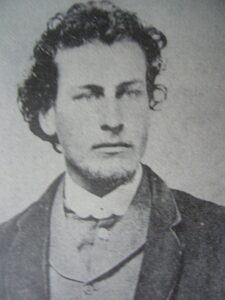
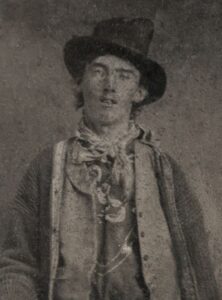 and they could only tend to their wounded and keep trying to get Roberts to come out. Nevertheless, none of them dared to approach their enemy’s fortress. Finally, Brewer circled around the main house, and took cover behind some stacked logs and opened fire on the room where the wounded man was laying on a mattress in front of the barricaded doorway. Roberts saw a cloud of gun smoke from the log pile. He opened fire when Brewer put his head up again, striking the cowboy in the eye. The Regulators, finally admitted defeat, pulled out, and left the area. Buckshot Roberts died from his wounds the next day. In the end, Roberts and Dick Brewer were buried side by side near the big house where the gunfight occurred. George W Coe, who survived the Blazer’s Mill fight, died in 1934.
and they could only tend to their wounded and keep trying to get Roberts to come out. Nevertheless, none of them dared to approach their enemy’s fortress. Finally, Brewer circled around the main house, and took cover behind some stacked logs and opened fire on the room where the wounded man was laying on a mattress in front of the barricaded doorway. Roberts saw a cloud of gun smoke from the log pile. He opened fire when Brewer put his head up again, striking the cowboy in the eye. The Regulators, finally admitted defeat, pulled out, and left the area. Buckshot Roberts died from his wounds the next day. In the end, Roberts and Dick Brewer were buried side by side near the big house where the gunfight occurred. George W Coe, who survived the Blazer’s Mill fight, died in 1934.
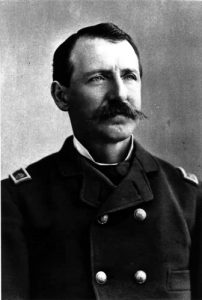 When people go missing these days, we are often not surprised. People seem to go missing all the time. Of course, most of them are murdered, or believed to be murdered. Very few are ever seen again, and as often as not, no one is ever prosecuted for their murder. This is not necessarily a new situation either. On February 1, 1896, one Albert Jennings Fountain and his eight year old son, Henry went missing near White Sands, New Mexico on their way home, after Fountain had attended a court term in Lincoln County. Mrs Fountain reported the two missing, and a search party was sent out the next day. On the Tularosa-Las Cruces road, about 45 miles from his home, the buckboard and team were found, along with Fountain’s papers, several empty cartridge casings, and two pools of blood. Missing were Fountain, his son, and Albert’s Winchester rifle.
When people go missing these days, we are often not surprised. People seem to go missing all the time. Of course, most of them are murdered, or believed to be murdered. Very few are ever seen again, and as often as not, no one is ever prosecuted for their murder. This is not necessarily a new situation either. On February 1, 1896, one Albert Jennings Fountain and his eight year old son, Henry went missing near White Sands, New Mexico on their way home, after Fountain had attended a court term in Lincoln County. Mrs Fountain reported the two missing, and a search party was sent out the next day. On the Tularosa-Las Cruces road, about 45 miles from his home, the buckboard and team were found, along with Fountain’s papers, several empty cartridge casings, and two pools of blood. Missing were Fountain, his son, and Albert’s Winchester rifle.
Albert Jennings Fountain was born in Staten Island, New York on October 23, 1838 to Solomon Jennings, a sea captain, and Catherine de la Fontaine Jennings, Albert grew up to go to Columbia College before traveling all over the world as a tutor. He then settled in California, where he worked at a newspaper before studying law in San Francisco. Though the reasons are unknown, Albert began to go by the name of “Albert Jennings Fountain,” an Anglicized version of his mother’s family name. In August, 1861 he enlisted in the Union Army and was commissioned as an officer in California Column. He participated in the Union conquest of the Confederate Territory of Arizona and fought at the Battle of Apache Pass.
During his time in the army, he married Mariana Perez in October, 1862 and the two would go on to have nine children. By the time he was discharged at the end of the Civil War, Albert had obtained the rank of captain. He and his family settled in El Paso, Texas, where he went to work for the United States Property Commission, which investigated and disposed of former Confederate property. Later he worked as a Customs Collector, was appointed an election judge, and the Assessor and Collector of Internal Revenue for the Western District of Texas. With this background, it is not surprising that he decided to try politics and in 1869, he won a seat in the Texas Senate. Fountain’s radical Republican views angered many Texas Democrats…my kind of guy. During the El Paso Salt War, Albert got into a shootout with a man named B. Frank Williams on December 7, 1870. Albert was wounded three times, but he killed Williams.
In 1875, the Fountain family moved to Mesilla, New Mexico, where his wife was from. It was here that Fountain began his law practice. Southern New Mexico, at that time, was still subject to frequent Indian raids and in 1878, Fountain became a captain in the first company of militia in southeast New Mexico, fighting in the campaigns against Chief Victorio and Geronimo. Continuing to serve in the militia, Fountain would reach the rank of colonel, a title that he was called for the rest of his life. In 1881, he was appointed to defend Billy the Kid in his charge for murder. In 1885, Fountain moved to Las Cruces to prosecute Federal land frauds. In 1888, he was elected to the New Mexico legislature, eventually becoming speaker of the house. Afterwards, he became a special prosecutor for livestock associations. In 1894 convicted 20 men for cattle rustling. His work as a politician and an attorney acquired numerous enemies for Albert, a fact that would prove to be fatal.
After an investigation into the disappearence, it was thought that a noted New Mexico gunman and rancher named Oliver M. Lee, along with two of his employees named Jim Gililland and William “Billy” McNew had perpetrated the crime. Eventually, all three were tried for the crime, but were acquitted for lack of evidence, namely the bodies, and the case remained open, with the Fountain bodies having never been found. Some historians also believe that the famed Sheriff Pat Garrett was assassinated while heavily investigating the Fountain murder, and that he might have been getting close to answering the age old question, “who done it”.
 Every family has it’s black sheep, and I have recently found out that one of mine is that my 7th cousin 3 times removed is Billy the Kid. Most of the people in my family tree are good people, and many are presidents and even royalty, but there are still a few of them who were…a bit on the wild side. Billy the Kid was one of those. On September 23, 1875, William Henry McCarty was arrested for the first time after stealing a basket of laundry. I can’t imagine why he chose a basket of laundry, but that was his entry into the world of crime. The jails back then weren’t super secure, so Billy the Kid broke out of jail, and roamed the West, eventually earning a reputation as an outlaw and murderer and a rap sheet that allegedly included 21 murders.
Every family has it’s black sheep, and I have recently found out that one of mine is that my 7th cousin 3 times removed is Billy the Kid. Most of the people in my family tree are good people, and many are presidents and even royalty, but there are still a few of them who were…a bit on the wild side. Billy the Kid was one of those. On September 23, 1875, William Henry McCarty was arrested for the first time after stealing a basket of laundry. I can’t imagine why he chose a basket of laundry, but that was his entry into the world of crime. The jails back then weren’t super secure, so Billy the Kid broke out of jail, and roamed the West, eventually earning a reputation as an outlaw and murderer and a rap sheet that allegedly included 21 murders.
No one really knows much about William’s birth, other than his name and approximate year of birth…between 1859 and 1861, in Indiana or New York. William’s dad was never in his life, and the family moved around a lot, living in Indiana, Kansas, Colorado 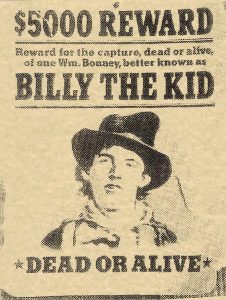 and Silver City, New Mexico. His mother died in 1874 and Billy the Kid…who went by a variety of names throughout his life, including Kid Antrim and William Bonney…turned to crime soon afterward. I guess that explains the decision to steal a basket of laundry. There are criminals who start out as good people, and then circumstances in their life force them to do things they might not otherwise do. Then, once they are into it, there is no going back. Billy the Kid became a horse thief in Arizona before returning to New Mexico, where he hooked up with a gang of gunslingers and cattle rustlers involved in the notorious Lincoln County War between a rival rancher and merchant factions in Lincoln County in 1878. It would be this time period that would eventually get him a death sentence.
and Silver City, New Mexico. His mother died in 1874 and Billy the Kid…who went by a variety of names throughout his life, including Kid Antrim and William Bonney…turned to crime soon afterward. I guess that explains the decision to steal a basket of laundry. There are criminals who start out as good people, and then circumstances in their life force them to do things they might not otherwise do. Then, once they are into it, there is no going back. Billy the Kid became a horse thief in Arizona before returning to New Mexico, where he hooked up with a gang of gunslingers and cattle rustlers involved in the notorious Lincoln County War between a rival rancher and merchant factions in Lincoln County in 1878. It would be this time period that would eventually get him a death sentence.
Billy the Kid wasn’t a big man, but rather had a slender build and prominent crooked front teeth. He loved to sing, and I have to wonder what he might have become had he chosen singing over crime. Nevertheless, after the Lincoln County War, he went on the lam and continued his outlaw’s life, stealing cattle and horses, gambling  and killing people. His crimes earned him a bounty on his head and he was eventually captured and indicted for killing a sheriff during the Lincoln County War.
and killing people. His crimes earned him a bounty on his head and he was eventually captured and indicted for killing a sheriff during the Lincoln County War.
Sentenced to hang for his crime, Billy the Kid managed to escape from jail one more time, murdering two deputies in the process. His freedom was short lived, however, as Sheriff Pat Garrett caught up with him at Fort Sumner, New Mexico, on July 14, 1881, and fatally shot him. Billy’s legend grew following his short life and violent death. Today he is a famous symbol of the Old West, along with such men as Kit Carson, Jesse James, Wild Bill Hickok, Doc Holliday and Wyatt Earp, and like many criminals of the past, his story has been romanticized in numerous films, books, TV shows and songs. Each year, tourists visit the town of Fort Sumner, located about 160 miles southeast of Albuquerque, to see the Billy the Kid Museum and gravesite.

